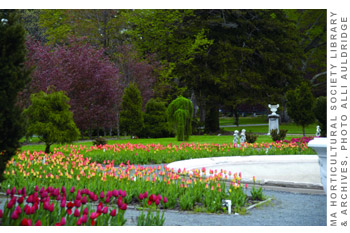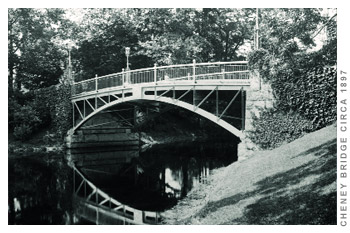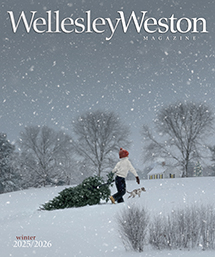Elm Bank
How these gardens are growing
Ruth Furman writer
Head west along Washington Street from Wellesley for a couple of miles, leave your worries behind, and delight in the bucolic landscape that emerges, with historic homes set  amidst parkland spaces. Turn onto an inconspicuous tree-lined drive that meanders and curves, cross a small bridge, and continue to follow the winding road past dog walkers, joggers, and mothers with strollers. As you reach a cluster of buildings, you know you have reached your destination, and it’s time to park your car and enjoy the best that nature has to offer. It was here, in 1740, that Colonel John Jones settled, after acquiring this parcel of land in Wellesley which is bounded on three sides by the Charles River. He planted elm trees along the river’s banks and built his private residence, naming it, of course, Elm Bank. There are no surviving records of Colonel Jones’ residence, but it is likely to have included a kitchen garden, a fruit orchard, and perhaps a flower garden.
amidst parkland spaces. Turn onto an inconspicuous tree-lined drive that meanders and curves, cross a small bridge, and continue to follow the winding road past dog walkers, joggers, and mothers with strollers. As you reach a cluster of buildings, you know you have reached your destination, and it’s time to park your car and enjoy the best that nature has to offer. It was here, in 1740, that Colonel John Jones settled, after acquiring this parcel of land in Wellesley which is bounded on three sides by the Charles River. He planted elm trees along the river’s banks and built his private residence, naming it, of course, Elm Bank. There are no surviving records of Colonel Jones’ residence, but it is likely to have included a kitchen garden, a fruit orchard, and perhaps a flower garden.
Through the decades, the Loring, Broad, and Otis families owned and occupied the site until Benjamin Pierce Cheney acquired it in 1874. He was the founder of the delivery company that later became American Express. Upon Cheney’s death, the property passed to his daughter, Alice Baltzell, who, with her husband, created their own country estate. They built a neo-Georgian manor house, set amid the picturesque landscaping that included a formal garden in the Italianate style designed by the Olmsted Brothers, the sons of landscape designer Frederick Law Olmsted, who designed Boston Public Garden and New York’s Central Park. The Cheney-Baltzell families occupied the manor until the 1940’s when the Stigmatine Fathers used it for seminary housing and a children’s summer camp. The estate suffered neglect after the family departed, but the landscape elements of the property were of such historic significance, that in 1987 the estate was placed on the National Register of Historic Places. The Commonwealth of Massachusetts currently owns this 182-acre site that includes woodlands, fields, and streams, while the Department of Conservation and Recreation (DCR) maintains it as a nature reserve with a trail system.
Today, Elm Bank is also home to the Massachusetts Horticultural Society (MHS). Founded in 1829, MHS is the oldest formally-organized horticultural institution in this country, and for most of its 175-year history, Boston has been its home. In 1999, the move to Elm Bank was made possible through a 99-year lease with the Commonwealth for a 36-acre parcel of land within the Elm Bank Reservation.
The site provides the MHS with space to achieve its vision of establishing a multifaceted horticultural and educational facility. It also provides an opportunity to restore historic gardens and protect and conserve a natural environment. An extensive $5.5 million capital campaign has allowed the MHS to convert the property into a facility that houses a visitor’s center, classrooms, workshops, exhibit areas, plant clinics, and a trial garden.
There are nine contemporary and historic gardens that are alive with horticultural activity and information and offer a blaze of color at the height of summer. The Noanett Garden  Club maintains a display of ornamental grasses, and the New England Chapter of the Herb Society of America offers a more formal space, at the center of which stands a Ginkgo tree surrounded by fragrant themed beds. The Rhododendron Society’s garden displays spectacular blooms in late spring into early summer, and the Daylily Society displays over 300 varieties summer to early fall. A garden for children, called “Weezie’s Garden,” designed by former Wellesley resident Julie Moir Messervy, provides interactive activities and special programs. The latest addition is the “Jim Crockett Memorial Garden,” named after the first host of WGBH-TV’s The Victory Garden, and the father of “how-to” garden television shows. This landscape design features poppies, one of Crockett’s favorite flowers, and granite memorial benches engraved with written tributes.
Club maintains a display of ornamental grasses, and the New England Chapter of the Herb Society of America offers a more formal space, at the center of which stands a Ginkgo tree surrounded by fragrant themed beds. The Rhododendron Society’s garden displays spectacular blooms in late spring into early summer, and the Daylily Society displays over 300 varieties summer to early fall. A garden for children, called “Weezie’s Garden,” designed by former Wellesley resident Julie Moir Messervy, provides interactive activities and special programs. The latest addition is the “Jim Crockett Memorial Garden,” named after the first host of WGBH-TV’s The Victory Garden, and the father of “how-to” garden television shows. This landscape design features poppies, one of Crockett’s favorite flowers, and granite memorial benches engraved with written tributes.
Thomas Herrara-Mishler, Executive Director of MHS since early 2005, says his mission is to continue to expand the offerings at Elm Bank. Trained as a landscape architect, he spent ten years with the Philadelphia Flower Show, the largest indoor flower show in the world, and most recently served as Director of Airlie Gardens in Wilmington, NC. His passion for the future of the Society is evident when he talks about Elm Bank and his vision to transform it into a premier public garden. A native of South America, Herrara-Mishler and his wife, who is from Costa Rica, are now acclimated to New England weather and are delighted to be living in Wellesley with their three daughters.
The trial gardens, located in front of the main administration building, are a full bloom of color in the summer, and feature annuals grown mainly from seed contributed by international plant breeders. Plans are in place to renovate this area to become more hospitable to public viewing. The visitor arrival area will receive a facelift as well, and will include a café for visitors who come to view the gardens and walk the paths. One of Herrara-Mishler’s major goals is to restore the manor house and establish it as the new Horticultural Hall. He considers the library’s internationally-renowned collection to be the jewel in the crown of the organization. It includes seed catalogues dating back to the 1800s, an extensive collection of botanical prints, and over 1,000 glass slides of nineteenth-century gardens.
To support its many endeavors, the MHA currently depends on revenues from membership, individual and corporate contributions, the MHS gift shop, and the New England Spring Flower Show, the premier event of the spring season.
The New England Spring Flower Show was established in 1871 as an annual event. At that time, Boston Harbor was an active port with travelers from foreign shores who visited the exhibitions and contributed knowledge, seeds, and plants – all of which are carefully documented and catalogued by the Society. The Victorian era gave rise to explorers who combed the earth to identify new plants. The MHA sponsored plant expeditions to the Far East, sometimes jointly with the Arnold Arboretum or with supportive members of the Society. Thus, new varieties of exotic and ornamental plants arrived in Boston, which were then displayed for the first time at the annual flower show. Throughout its history, the MHS has championed the introduction of new plants into the US, in recognition of the need for accurate documentation about new plants, not just those native to North America.
In 1983, the show moved to the Bayside Exposition Center, where it continues today to exhibit exceptional displays in landscape design. It was at these early shows that garden clubs made their debut into serious gardening, and amateur horticulture was encouraged for both adults and children. The New England Spring Flower Show, as it is now called, is the world’s longest continuously running flower show, and the largest event held indoors in New England. The Spring Flower Show for 2006 (Welcome Home! Celebrating Our Great New England Landscape) kicks off with a preview on March 10.
MHS has nurtured many other horticultural organizations, such as the Wildflower Society, the Garden Club Federation, the Herb Society of America, and most recently the New England Garden History Society, established in1990, that concentrates on New England landscapes but also features gardens from all over the country in their internationally-recognized publication.
Elm Bank has something for every garden lover in every season. If you are looking to enhance your horticultural expertise, the winter lecture series will help. For a more intensive experience, the Master Gardener training program will fit the bill. Even if you just want to take a walk, Elm Bank is the place to go.
© 2006 Elm Bank Media



recent comments